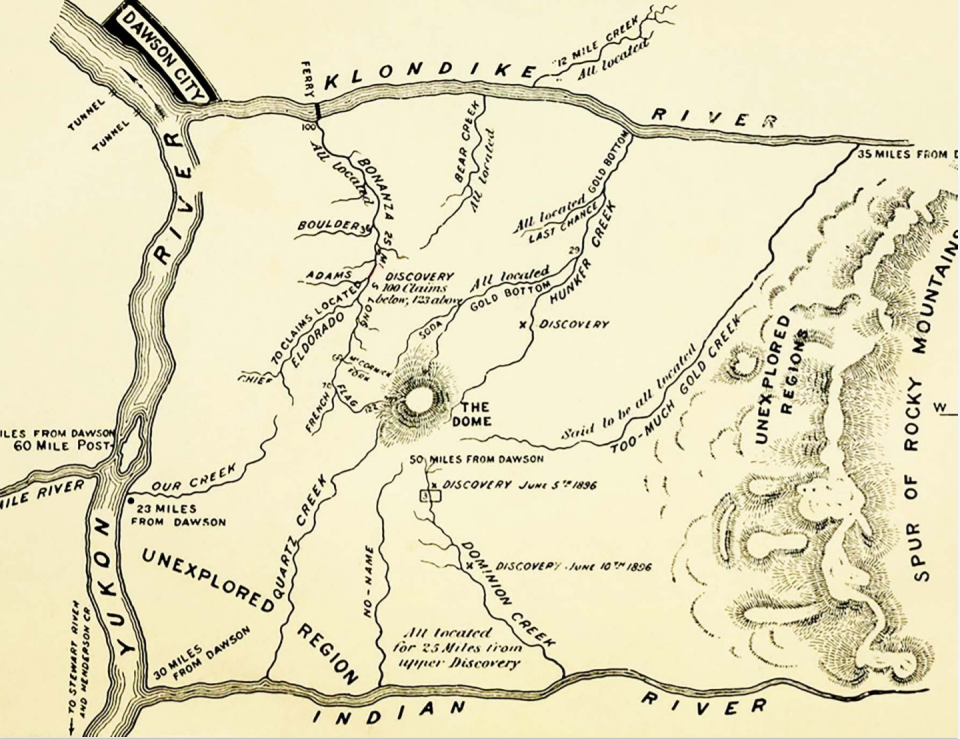Klondike fever, Elmira style: How the gold rush took an Elmira expedition to Alaska
- Oops!Something went wrong.Please try again later.
Klondike fever was rampant in Elmira in January, February, and March 1898. Local folks from all over New York and Pennsylvania were bound for Alaska. We wanted GOLD. It was the 1849 gold rush all over again.
Alaska Mining and Prospecting Company of Elmira began in 1897 with President John M. Diven and Vice President Charles N. Gridley. They obtained an option upon a claim of 20 acres on Forty Mile Creek. They also began negotiating to purchase an interest on Eldorado Creek. Elmirans eagerly purchased all 11,000 shares of their stock.
On May 6, 1898, the Elmira Daily Gazette reported that a local group of seven wanted to try prospecting. A week before they left, they dined at a banquet at the Elmira City Club. Dinner included Little Neck Clams, Consommé au Profiteroles, Yukon Brook Trout, Spring Lamb with mint sauce, Creamed New Potatoes, Asparagus Tips on toast, Lobster, and Strawberries for dessert.
After dinner, a presentation was given by Professor Andrew Sherwood of Mansfield, Pennsylvania. He explained that not only was the group looking for gold, but they were also representatives of the United States Geological Survey with a view to the publication of a new map showing the gold and other mineral resources in Alaska. The Trail Creek and Boundary District “are a veritable Eldorado,” according to Mr. Sherwood. “There are still plenty of mining opportunities.”

After the feast, Mr. Sherwood gave the itinerary of the proposed expedition. He expected a positive outcome because the group was well-equipped with certain knowledge of the mineral resources. The directors had great faith. The group was most anxious about leaving Elmira and unable to communicate with their families for many months.
The expedition to the “vast, undeveloped, untrodden northwest,” as Mr. Sherwood said, “has the best-laid plans and the best chances of any party that will enter the Alaskan country this season.” He explained that his chosen route for the group was the cheapest, safest and easiest. Game and fish were plentiful – caribou, moose, grouse, ducks, geese, salmon and trout were there for the taking.
From the Daily Gazette on May 18, 1898: “Early in the morning at 3:17 a.m., the ‘Elmira Expedition’ left on Lackawanna train No. 7 with seven sturdy men who are to seek their fortunes in the gold regions of Alaska.” The group included Professor Andrew Sherwood, C.B. Sherwood, E.A. Kirberger, Alfred Stacey, Dr. Charles Beech (all of Pennsylvania), and H.S. Johnson of Elmira.
Once the group left, details of the trip came through telegrams and letters from far away. The Daily Gazette published updates when it could.
On the first report — May 24, 1890 — the group had reached Vancouver. Google says it is a distance of 2,848 miles. Dr. Sherwood sent the Gazette a list of all the items they had purchased. The Hudson Bay Company furnished all the supplies needed for one year in Vancouver and one year in Glenora, British Columbia. Glenora? According to Wikipedia, it is not related to our Glenora, but rather Gaelic “glenn” for valley and Spanish “ora” for gold. Valley of Gold. Also, in Vancouver, they acquired cayuses. Cayuses are “tough little Canadian horses.”
More updated reports to the Daily Gazette followed in intervals.
June 2, 1898: The group reached Victoria, British Columbia.
July 11, 1898: On the Lake Teslin trail – Sherwood said this was “probably the last letter of the season.”
Sept 27, 1898: The last time the board of directors heard from Sherwood.
Jan 10, 1899: A report that they were at Fort Wrangel, Alaska. Sherwood wrote “that they are living in a cabin. They had located several promising claims on Atlin Lake, but the weather is bad.”
On Feb 16, 1899: The Gazette reported “Elmira Company Strikes it Rich” with their claim on Eldorado Creek.
On May 4, 1899: The Gazette reported that the company’s claim is paying good money [to its investors].
On May 9, 1899: The Gazette reported “Rich Strikes in the Klondike – Two Claims on Bonanza.”
Finally, the Elmira Daily Gazette reported on May 11, 1899, that “all but one of the seven have returned from the land of the gold.” “Just what was accomplished by the party is not known, and the company's directors in this city are uncommunicative regarding the matter.”
Sherwood reported that the group split in half - half looking for gold and half looking for coal.
Coal was found, and stockholders “would each reap a fortune from the mines.”
Reviving history: This 140-year-old Elmira mansion needs $3 million in work. Why a mother and daughter bought it
On April 7, 1900, the Gazette reported that a sample of the coal deposit was tested at Cornell University, and the ore was "of a superior quality to that of any of the Pacific coal." Five hundred men were soon expected to work in the next season.
The investors made out pretty good with coal, not gold. On May 7, 1900, the company calculated $20 million in profits from coal. “There is no doubt that this strike will develop the greatest coal mine in the west, and the members of the company will reap a fortune from their stock.”
The last mention of the company in the newspapers was on Sept. 19, 1900.
— Diane Janowski is the Elmira City Historian.
This article originally appeared on The Evening Tribune: How the 19th century gold rush took an Elmira expedition to Alaska

